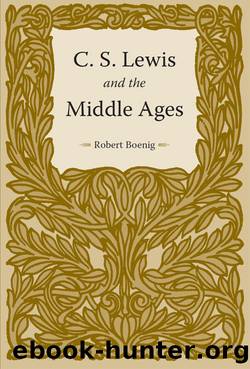C. S. Lewis and the Middle Ages by Robert Boenig

Author:Robert Boenig
Language: eng
Format: epub
Tags: C. S. Lewis and the Middle Ages
ISBN: 9781606351147
Publisher: The Kent State University Press
Published: 2013-10-14T00:00:00+00:00
4
A Moustache and a Fishhook
The last chapter addressed what Lewis really did to a variety of prior texts. Out of the Silent Planet and Prince Caspian are both reworkings of specific booksâone a riposte to H. G. Wells and the other a redirection of William Morris. The Great Divorce, however, was Lewisâs response to a whole genre, though Danteâs Divine Comedy has pride of place in that genre as the first among equals. Each of Lewisâs books here is dominated by his debate or engagement with the prior text or texts. But he was also capable of fashioning a riposte to a prior text as a supporting point in a book whose main engagement is with other texts and issues. Sometimes he wrote books in reaction not to a single prior text but to a prior idea that he wished to clarify. This chapter develops two examplesâhis liberation of the medieval figure of Merlin in That Hideous Strength not simply from a centuries-long hibernation but also from what Lewis thought was a vandalistic treatment at the hands of T. H. White and also Lewisâs profound synthesis of the three competing models of Christâs Atonement when crafting Aslanâs salvific work in The Lion, the Witch and the Wardrobe.
As mentioned, That Hideous Strength can profitably be studied as âWhat Lewis really did to Charles Williamsâs supernatural thrillers.â Lewisâs Ransom may have begun his career as a tribute to Tolkienâa philologist on a walking tourâbut he ends up as a portrait of Charles Williamsâa charismatic proponent of Williamsâs doctrine of co-inherence who attracts a company of followers much as Williams in real life seemed to do.1 The novel reads very much like one of Williamsâs, with supernatural events and magic gradually entering and then dominating everyday lifeâall with souls, even worlds hanging in the balance. What Lewis really does to Williamsâs books, like Many Dimensions and War in Heaven, is celebrate them, incorporating them into the model of the cosmos that he expounded in The Discarded Image and employed in Out of the Silent Planet and Perelandra. This, I think, is quite clearly his main purpose, and a number of fine critics have discussed That Hideous Strength in terms of its relationship to Williamsâs books.2 But I suggest that there is a secondary motive behind Lewisâs novel involving not just a celebration of prior texts but also an argument with one. In a way, it is similar to what Lewis really does to Wellsâs The First Men in the Moon, but the difference is that Lewis does not choose to refashion someone elseâs plot. Instead, he refashions someone elseâs character.
As he made clear in his letters, he did not like the famous book by his contemporary T. H. White, The Once and Future King, in which Merlin (whose name White, following the spelling of William Caxtonâs edition of Maloryâs Le Morte Darthur, renders âMerlynâ). Lewis responded to Whiteâs book by fashioning the character Merlin in That Hideous Strength in ways he thought more
Download
This site does not store any files on its server. We only index and link to content provided by other sites. Please contact the content providers to delete copyright contents if any and email us, we'll remove relevant links or contents immediately.
4 3 2 1: A Novel by Paul Auster(11823)
The handmaid's tale by Margaret Atwood(7471)
Giovanni's Room by James Baldwin(6830)
Asking the Right Questions: A Guide to Critical Thinking by M. Neil Browne & Stuart M. Keeley(5370)
Big Magic: Creative Living Beyond Fear by Elizabeth Gilbert(5364)
Ego Is the Enemy by Ryan Holiday(4971)
On Writing A Memoir of the Craft by Stephen King(4677)
The Body: A Guide for Occupants by Bill Bryson(4603)
Ken Follett - World without end by Ken Follett(4453)
Bluets by Maggie Nelson(4283)
Adulting by Kelly Williams Brown(4246)
Eat That Frog! by Brian Tracy(4171)
Guilty Pleasures by Laurell K Hamilton(4128)
White Noise - A Novel by Don DeLillo(3838)
The Poetry of Pablo Neruda by Pablo Neruda(3828)
Fingerprints of the Gods by Graham Hancock(3749)
Alive: The Story of the Andes Survivors by Piers Paul Read(3743)
The Book of Joy by Dalai Lama(3713)
The Bookshop by Penelope Fitzgerald(3629)
